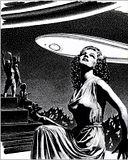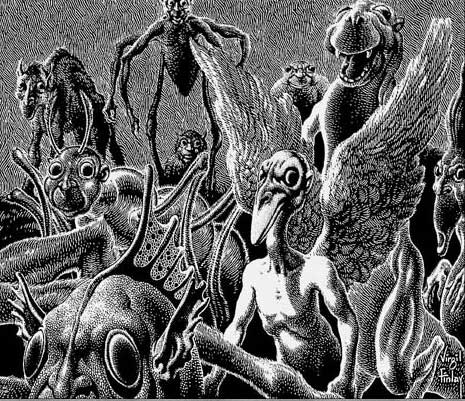My previous posts have given a very brief overview of religion and gods in Athanor. This is quite intentional. The Gods of Athanor are not common forces in the lives of the people of Athanor, as gods are often are in role-playing games. Rather, the gods do not grant magical power. Some gods are fictional or misinterpretations of historical figures. Others are powerful beings of supernatural power, but are not truly divine. Religion on Athanor is just another institution, corrupt and troublesome as any other. I have treated religion as just a bit of background color, but with a little meat on its bones, the topic of religion can provide a little more structure to the game.
The Churches of Law
The churches of Law are highly revered throughout the Five Kingdoms. Part of this respect is the fact that the churches are highly conservative, institutionalized, and support the ideals of social order, rule of law, and polite society. While people follow such tenets wih varying degrees of devotion, these ideals tend to resonate strongly with the general populace, and have the ring of social truth in them.
Though they are closely allied, the Churches of Law consist of three separate churches, each with its own focus.
Fala the Lightbringer
The Church of Fala the Lightbringer preaches the virtues of charity, social giving, sacred life and social justice. It runs several charities, and is devoted to running soup kitchens, hospitals, and schools throughout the Five Kingdoms. They teach the value of obedience, piety, self-discipline, and kindness, and are active missionaries in spreading the faith.
The priests of Fala swear oaths of chastity and poverty, though they may carry and use the wealth of the church. Thus, they may have items on extended loan from the church, but may own nothing of their own. Thus, any appearance of wealth among the holy is just a misunderstanding, as the faithful own nothing and but use what is given them by Fala.
They teach that it is a kindness to educate heathens in the Way, and thus support the Inquisition of the Serinites. They believe that virtue is hard work, and thus demand much work from penitents. They oppose moral weakness in the form of Chaos and heathen idolatry, and work to make sure that the State supports the churches of law only. They would love to convert Alemania from their heathen atheism to understanding the True Way.
For its charity work, the Church controls much wealth, and collects it aggressively from the faithful. Such wealth grants great power, and the control much land in order to do their work. Many of the younger children of the ruling families of the Five Kingdoms are sent to the Church to learn and to form stronger ties to the church for their families. Some might see this as poltical manipulation or finding a way to divert vst church funds to the wealthy, but such a perspective would be bitter and jaded.
Malkut the Scholar
The god Malkut and his church are dedicated to learning and scholarship, searching Ancient tomes not only for learning and facts, but for spiritual enlightenment on the nture of the universe. The Malkuti teach the value of keeping the mind focused on the Word and the Way, of studying and interpreing the Holy Word for insights into the world at large, and of properly educating the faithful.
The priests and priestesses of Malkut swear vows of poverty. They focus on developing a demeanor that is detached, thoughtful, and driven by philosophical and intellectual devotion to the holy teachings of the Gods of Law. They are builders of schools and libraries, and use teaching as a form of missionary work.
They teach the values of self-reflection, self-discipline, prayer, service, and obdedience to the Way of Malkut. Their teaching and spiritual work focus on mental discipline, devotiton of religious study, and finding ways to unite the Word with the World.
The Church of Malkut controls most of the large collections of books and scholarship extant in the Five Kingdoms, including carefully guarded libraries of forbidden lore. They are always seeking ways to gain more knowledge, translate Ancient books, and learn more of the history and science of the past.
Serin of the Iron Fist
Serin is the goddess of discipline and protector of the faithful. She is the Fist of Law, who teaches that strength of resolve is the highest system of belief, even beyond the evidence of reason or material evidence. Her followers form a small but fanatical order of fighting priests who act as defenders of caravans, protectors of religious missions, and hunters of abominations and witches. The Serinites form two orders: the Knights of the Temple, who defend churches of law and caravans of the faithful; the Knights of the Flame, who hunt monsters and witches, and act as the investigators for the church. They ae often called the Inquisition.
Priests and priestesses of Serin swear oaths of poverty and chastity, and live ascetic lives that involve dedication to spiritual and physical warfare. Their order follow military lines, with brother- and sister-soldiers, and father- and mother- sergeants, lieutenants, and captains. These ranks are highly ordered and disciplined, with strict codes of obedience and procedure.
The Serinites have the least to do with common folk, focusing on their war on spiritual evil in the world. This ofen makes them seem cold, distant, even cruel to outsiders who do not understand the need for strict dedication to the war against Evil in order to protect the innocent.
The Churches of Chaos
In contrast to the the churches of Law, the disparate churches of Chaos promise practices that support individual freedoms of expression and behavior. While the churches of Law are socially sanctioned, institutionalized, and tied to the greater social order, the churches of Chaos present themselves as counter-cultural or revolutionary, even if this is only marginally true. There are dozens of Churches of Chaos, but in Zamora, six churches are currently active.
Asheba the Creator
The Church of Asheba is devoted to artists, craftspeople, and magic-users. This means that it has lasting attentions to several guilds, noble families, and powerful individuals. This is the most mainstream of the chaos cults, and stresses the role of creation as a positive. As an outgrowth, the church is tied to charitable work in feeding the poor, opening schools, and providing alternative voices to those who wish to challenge the hegemony of the churches of Law.
The priests and priestesses of Asheba have no single code of dress or conduct, but follow loose guidelines for kindness, ethical behavior, and respect for life. They stand for freedom and individuality as well. They do not take oaths of poverty or chastity, instead focusing on oaths of service.
Due to the church’s followers, the Ashebans have a great deal of wealth and influence, making them a thorn in the side of the churches of Law. This is a position Ashebans relish, considering themselves social gadflies and potential change agents.
Bel the Liberator
The church of Bel is devoted to serving the poor and downtrodden. They not only set up charities in the poorest communities, but serve as a voice of liberation and opposition to slavery, exploitation, and centralized government. As a result, the church of Bel is outlawed quite broadly, and its churches quickly razed.
In Zamora, this church is underground, gathering its followers in the barrens on the edge of the city. Beggars and outcasts are its followers, and its leaders are trained insurgents who are generally from lesser families of wealth who have cast aside their former lives out of disillusionment.
Bel’s followers are known to participate in resistance acts ranging from protests and heckling to vandalism to direct acts of violence. Different cells have different goals, but the authorities treat all of them as potential sites for resistance and violence.
Checkah the Trickster
The god of trickery is the subject of many popular tales, and the worship of Checkah is popular among gamblers, the poor, and criminals. The Church of Checkah, however, is the precinct of a small group of criminals and anarchists, who practice their worship in the Undercity. Checkah followers believe that they can show their beliefs best through committing memorable crimes, practical jokes, or acts of sabotage that will make them legendary in renown. His followers have no church as such, but gather as cells to share tales, conspire together, and add adventure to the world.
Kesh the Destroyer
The cult of Kesh is outlawed, since the worship of Kesh is the worship of death and destruction. Kesh worship is ecstatic, involving orgies of drugs and sex in which worshipers receive visions of the god, promising paradise eternal to those who unlease his blessings of violence on the world. His priests meet secretly with followers, seeking ways to bring turmoil and conflict to the world. Few would openly admit worship of this god.
Tala the Corruptor
The cult of Tala is likewise outlawed, in many ways a more subtle counterpart to Kesh. Unlike Kesh, Tala’s cult believes the world is debased, and the only way to purify the soul is to cleanse it through experiencing its baseness without pretension. They believe cruelty, murder, violence, and decadence are steps on the path to enlightenment and that by expressing all the worst in you, you will reach a point where you are cleansed of evil, and become pure. They feel their goal is to guide all they can through the same process, tempting others to evil and exposing the corruption of mortal life so that all souls may find peace beyond their own mortality. Talans work in small cells of no more than 3 individuals, who meet in masks and hide their identities from one another. Their actions are criminal and dangerous, and Talans are hunted.
Vanya of the Silken Thighs
The Temple of Vanya of the Silken Thighs has a high priestess and a body of priests and priestesses that worship the goddess of pleasure through carnal sacrifice, charging alms from worshippers for the privelege of blessed congress. This is a wealthy temple, despite its lack of political influence, with many worshippers coming through its doors every day.

















